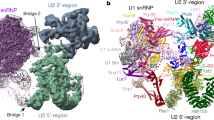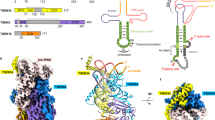Abstract
Intron removal in nuclear precursor mRNA is catalyzed through two transesterification reactions by a multi-megaDalton ribonucleoprotein machine called the spliceosome. A complex between U2 and U6 small nuclear RNAs is a core component of the spliceosome. Here we present an NMR structural analysis of a protein-free U2–U6 complex from Saccharomyces cerevisiae. The observed folding of the U2–U6 complex is a four-helix junction, in which the catalytically important AGC triad base-pairs only within U6 and not with U2. The base-pairing of the AGC triad extends the U6 intramolecular stem-loop (U6 ISL), and the NMR structure of this extended U6 ISL reveals structural similarities with domain 5 of group II self-splicing introns. The observed conformation of the four-helix junction could be relevant to the first, but not the second, step of splicing and may help to position the U6 ISL adjacent to the 5′ splice site.
This is a preview of subscription content, access via your institution
Access options
Subscribe to this journal
Receive 12 print issues and online access
$189.00 per year
only $15.75 per issue
Buy this article
- Purchase on Springer Link
- Instant access to full article PDF
Prices may be subject to local taxes which are calculated during checkout





Similar content being viewed by others
References
Nilsen, T.W. RNA-RNA Interactions in Nuclear Pre-mRNA Splicing (Cold Spring Harbor Laboratory Press, Cold Spring Harbor, New York, 1998).
Brow, D.A. Allosteric cascade of spliceosome activation. Annu. Rev. Genet. 36, 333–360 (2002).
Jacquier, A. Self-splicing group II and nuclear pre-mRNA introns: how similar are they? Trends Biochem. Sci. 15, 351–354 (1990).
Moore, M.J. & Sharp, P.A. Evidence for two active sites in the spliceosome provided by stereochemistry of pre-mRNA splicing. Nature 365, 364–368 (1993).
Padgett, R.A., Podar, M., Boulanger, S.C. & Perlman, P.S. The stereochemical course of group II intron self-splicing. Science 266, 1685–1688 (1994).
Villa, T., Pleiss, J.A. & Guthrie, C. Spliceosomal snRNAs: Mg(2+)-dependent chemistry at the catalytic core? Cell 109, 149–152 (2002).
Valadkhan, S. & Manley, J.L. Splicing-related catalysis by protein-free snRNAs. Nature 413, 701–707 (2001).
Valadkhan, S. & Manley, J.L. Characterization of the catalytic activity of U2 and U6 snRNAs. RNA 9, 892–904 (2003).
Madhani, H.D. & Guthrie, C. A novel base-pairing interaction between U2 and U6 snRNAs suggests a mechanism for the catalytic activation of the spliceosome. Cell 71, 803–817 (1992).
Wu, J. & Manley, J.L. Mammalian pre-mRNA branch site selection by U2 snRNP involves base pairing. Genes Dev. 3, 1553–1561 (1989).
Parker, R., Siliciano, P.G. & Guthrie, C. Recognition of the TACTAAC box during mRNA splicing in yeast involves base pairing to the U2-like snRNA. Cell 49, 229–239 (1987).
Newby, M.I. & Greenbaum, N.L. Sculpting of the spliceosomal branch site recognition motif by a conserved pseudouridine. Nat. Struct. Biol. 9, 958–965 (2002).
Lesser, C.F. & Guthrie, C. Mutations in U6 snRNA that alter splice site specificity: implications for the active site. Science 262, 1982–1988 (1993).
Kandels-Lewis, S. & Seraphin, B. Involvement of U6 snRNA in 5′ splice site selection. Science 262, 2035–2039 (1993).
Sun, J.S. & Manley, J.L. A novel U2–U6 snRNA structure is necessary for mammalian mRNA splicing. Genes Dev. 9, 843–854 (1995).
Hilliker, A.K. & Staley, J.P. Multiple functions for the invariant AGC triad of U6 snRNA. RNA 10, 921–928 (2004).
Datta, B. & Weiner, A.M. The phylogenetically invariant ACAGAGA and AGC sequences of U6 small nuclear RNA are more tolerant of mutation in human cells than in Saccharomyces cerevisiae. Mol. Cell. Biol. 13, 5377–5382 (1993).
Field, D.J. & Friesen, J.D. Functionally redundant interactions between U2 and U6 spliceosomal snRNAs. Genes Dev. 10, 489–501 (1996).
Yan, D. & Ares, M. Jr. Invariant U2 RNA sequences bordering the branchpoint recognition region are essential for interaction with yeast SF3a and SF3b subunits. Mol. Cell. Biol. 16, 818–828 (1996).
Fortner, D.M., Troy, R.G. & Brow, D.A. A stem/loop in U6 RNA defines a conformational switch required for pre-mRNA splicing. Genes Dev. 8, 221–233 (1994).
Huppler, A., Nikstad, L.J., Allmann, A.M., Brow, D.A. & Butcher, S.E. Metal binding and base ionization in the U6 RNA intramolecular stem-loop structure. Nat. Struct. Biol. 9, 431–435 (2002).
Yean, S.L., Wuenschell, G., Termini, J. & Lin, R.J. Metal-ion coordination by U6 small nuclear RNA contributes to catalysis in the spliceosome. Nature 408, 881–884 (2000).
Sigel, R.K., Vaidya, A. & Pyle, A.M. Metal ion binding sites in a group II intron core. Nat. Struct. Biol. 7, 1111–1116 (2000).
Boulanger, S.C. et al. Studies of point mutants define three essential paired nucleotides in the domain 5 substructure of a group II intron. Mol. Cell. Biol. 15, 4479–4488 (1995).
Clore, G.M. & Kuszewski, J. Improving the accuracy of NMR structures of RNA by means of conformational database potentials of mean force as assessed by complete dipolar coupling cross-validation. J. Am. Chem. Soc. 125, 1518–1525 (2003).
Reiter, N.J., Nikstad, L.J., Allmann, A.M., Johnson, R.J. & Butcher, S.E. Structure of the U6 RNA intramolecular stem-loop harboring an S(P)-phosphorothioate modification. RNA 9, 533–542 (2003).
Peebles, C.L., Zhang, M., Perlman, P.S. & Franzen, J.S. Catalytically critical nucleotide in domain 5 of a group II intron. Proc. Natl. Acad. Sci. USA 92, 4422–4426 (1995).
Zhang, L. & Doudna, J.A. Structural insights into group II intron catalysis and branch-site selection. Science 295, 2084–2088 (2002).
Sigel, R.K. et al. Solution structure of domain 5 of a group II intron ribozyme reveals a new RNA motif. Nat. Struct. Mol. Biol. 11, 187–192 (2004).
Ryan, D.E. & Abelson, J. The conserved central domain of yeast U6 snRNA: importance of U2–U6 helix Ia in spliceosome assembly. RNA 8, 997–1010 (2002).
Fabrizio, P. & Abelson, J. Point mutations in yeast U6 snRNA can specifically block the first or second step of pre-mRNA splicing in vitro. Mol. Biol. Rep. 14, 135 (1990).
Hohng, S. et al. Conformational flexibility of four-way junctions in RNA. J. Mol. Biol. 336, 69–79 (2004).
Rupert, P.B. & Ferre-D'Amare, A.R. Crystal structure of a hairpin ribozyme-inhibitor complex with implications for catalysis. Nature 410, 780–786 (2001).
Tani, T. & Ohshima, Y. mRNA-type introns in U6 small nuclear RNA genes: implications for the catalysis in pre-mRNA splicing. Genes Dev. 5, 1022–1031 (1991).
Tarn, W.Y. & Steitz, J.A. Highly diverged U4 and U6 small nuclear RNAs required for splicing rare AT-AC introns. Science 273, 1824–1832 (1996).
Konforti, B.B. et al. Ribozyme catalysis from the major groove of group II intron domain 5. Mol. Cell 1, 433–441 (1998).
Madhani, H.D. & Guthrie, C. Randomization-selection analysis of snRNAs in vivo: evidence for a tertiary interaction in the spliceosome. Genes Dev. 8, 1071–1086 (1994).
Hansen, M.R., Hanson, P. & Pardi, A. Filamentous bacteriophage for aligning RNA, DNA, and proteins for measurement of nuclear magnetic resonance dipolar coupling interactions. Methods Enzymol. 317, 220–240 (2000).
Ottiger, M., Delaglio, F., Marquardt, J.L., Tjandra, N. & Bax, A. Measurement of dipolar couplings for methylene and methyl sites in weakly oriented macromolecules and their use in structure determination. J. Magn. Reson. 134, 365–369 (1998).
Brunger, A.T. et al. Crystallography and NMR system: a new software suite for macromolecular structure determination. Acta Crystallogr. D 54, 905–921 (1998).
Sashital, D.G., Allmann, A.M., Van Doren, S.R. & Butcher, S.E. Structural basis for a lethal mutation in U6 RNA. Biochemistry 42, 1470–1477 (2003).
Schwieters, C.D., Kuszewski, J.J., Tjandra, N. & Marius Clore, G. The Xplor-NIH NMR molecular structure determination package. J. Magn. Reson. 160, 65–73 (2003).
Acknowledgements
We thank C.J. McManus for sample preparation, and M. Tonelli and the National Magnetic Resonance Facility (NMRFAM) staff for technical support. NMR studies were carried out at NMRFAM with support from the US National Institutes of Health (NIH) Biomedical Technology Program and additional equipment funding from the University of Wisconsin, the US National Science Foundation (NSF) Academic Infrastructure Program, the NIH Shared Instrumentation Program, the NSF Biological Instrumentation Program, and the US Department of Agriculture. This investigation was supported by NIH grant GM65166 to S.E.B. and by NIH predoctoral training grant T32 GM007215 to D.G.S.
Author information
Authors and Affiliations
Corresponding author
Ethics declarations
Competing interests
The authors declare no competing financial interests.
Supplementary information
Supplementary Fig. 1
U2-U6 complexes used in NMR study. (PDF 78 kb)
Supplementary Fig. 2
NMR evidence for four-helix junction in all U2–U6 complexes. (PDF 126 kb)
Supplementary Fig. 3
Overlay of 2D NOESY sequential region for extended U6 ISL and U2–U6 complex. (PDF 123 kb)
Rights and permissions
About this article
Cite this article
Sashital, D., Cornilescu, G. & Butcher, S. U2–U6 RNA folding reveals a group II intron-like domain and a four-helix junction. Nat Struct Mol Biol 11, 1237–1242 (2004). https://doi.org/10.1038/nsmb863
Received:
Accepted:
Published:
Issue Date:
DOI: https://doi.org/10.1038/nsmb863
This article is cited by
-
19F-labeling of the adenine H2-site to study large RNAs by NMR spectroscopy
Journal of Biomolecular NMR (2016)
-
Evolution of group II introns
Mobile DNA (2015)
-
Evidence for a group II intron–like catalytic triplex in the spliceosome
Nature Structural & Molecular Biology (2014)
-
Core structure of the U6 small nuclear ribonucleoprotein at 1.7-Å resolution
Nature Structural & Molecular Biology (2014)
-
RNA structure analysis of human spliceosomes reveals a compact 3D arrangement of snRNAs at the catalytic core
The EMBO Journal (2013)



